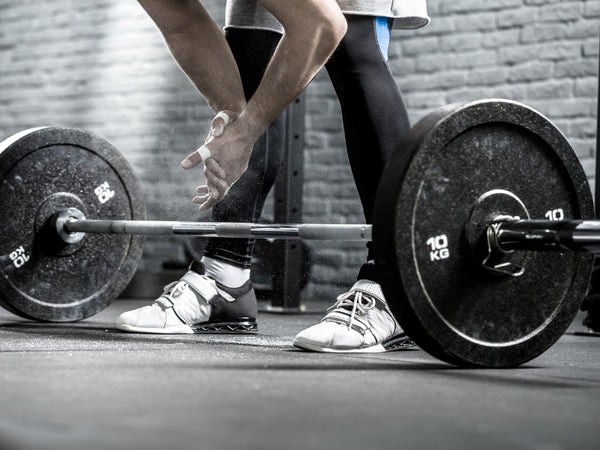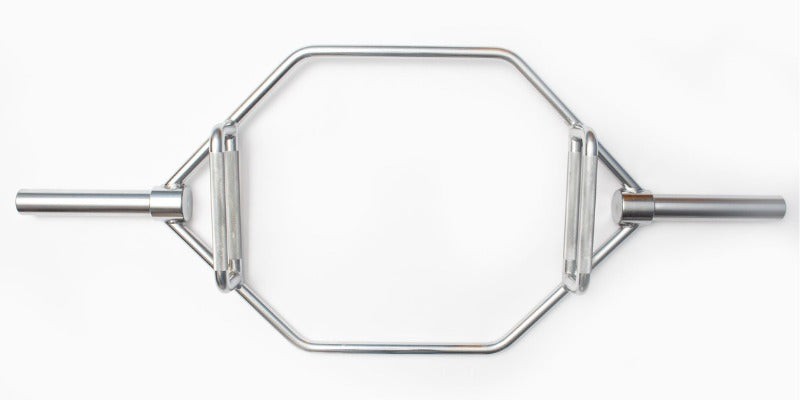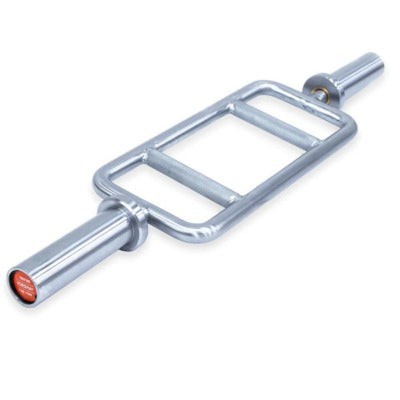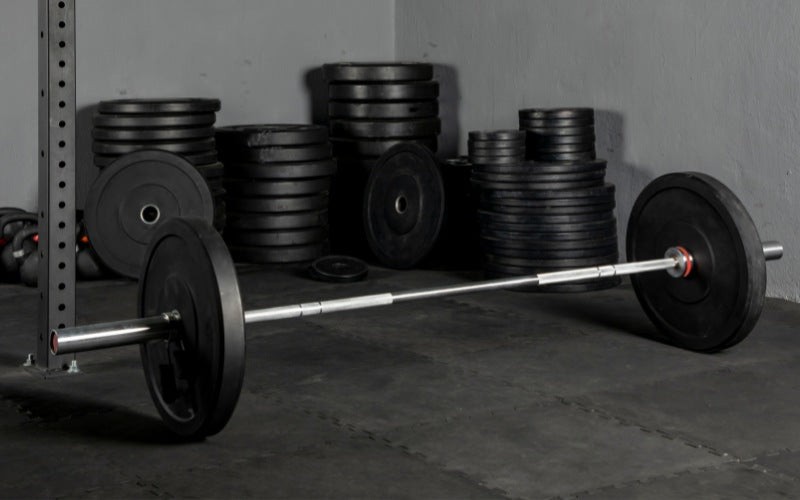How Much Does A Bar At The Gym Weigh is a question many fitness enthusiasts ask, especially when tracking progress. Understanding the weight of different barbells is crucial for accurate workout planning and performance assessment. At HOW.EDU.VN, we provide expert guidance to help you optimize your fitness journey. Explore the different types of barbells, their weights, and why it all matters for your training. Let’s delve into barbell variations, weightlifting equipment, and strength training essentials.
1. Understanding the Barbell: An Overview
A barbell is a fundamental piece of equipment in various strength training disciplines, including weightlifting, powerlifting, bodybuilding, and strongman competitions. Barbells consist of a long bar, typically ranging from 4 to 8 feet in length, designed to accommodate weight plates on its outer portions. This allows users to adjust the load according to their strength and training goals. The bar’s diameter can vary, influencing grip and overall feel.
Barbells are essential for compound exercises that engage multiple muscle groups simultaneously. Exercises like squats, deadlifts, bench presses, and overhead presses are commonly performed using barbells. The ability to progressively increase the weight on a barbell makes it an ideal tool for building strength and muscle mass.
2. Different Types of Barbells and Their Weights
The weight of a barbell can vary significantly depending on its type and intended use. Here’s a breakdown of different barbell types and their typical weights:
2.1. Standard Barbell Weight (1″ Spinlock)
Standard barbells typically feature a 1-inch diameter bar and are designed for use with weight plates that have a 1-inch hole. These barbells are commonly used in body pump classes and are suitable for home gyms.
-
Weight:
- 5ft bar: 12.8lbs (5.8kg)
- 6ft bar: 15lbs (6.8kg)
These bars often have threaded ends with spinlock collars to secure the weight plates.
2.2. Olympic Barbell Weight
The Olympic barbell is the most prevalent type found in commercial gyms. These barbells are designed to meet the specifications of the International Weightlifting Federation (IWF) and are used in Olympic weightlifting competitions.
- Weight: 45lbs (20kg)
- Length: 7.2 feet
Olympic barbells have rotating sleeves (2″ thick) to accommodate Olympic weight plates. The rotating sleeves reduce torque on the wrists and elbows during Olympic lifts like snatches and clean-and-jerks. This design feature is crucial for performing dynamic movements safely and efficiently.
2.3. Safety Squat Bar Weight
The safety squat bar is a specialized barbell designed to improve squat mechanics and reduce stress on the shoulders and wrists. It features padded shoulder rests and forward-facing handles, allowing the user to maintain a more upright torso position during squats.
- Weight: 60 to 75 pounds (27kg to 34kg)
The added weight of the padding and handles makes the safety squat bar heavier than a standard Olympic barbell. It’s an excellent option for those with shoulder mobility issues or those looking to vary their squat training.
2.4. Trap Bar/Hex Bar Weight
The trap bar, also known as a hex bar or shrug bar, is designed for deadlifts and shrugs. Its hexagonal frame allows the user to stand in the center of the bar, reducing stress on the lower back.
- Weight: Approximately 54lbs (25kg)
The weight can vary slightly depending on the length and construction of the bar. Trap bars are known for making deadlifts more accessible, especially for beginners or those with lower back issues.
2.5. The Multi-Grip Bar
The multi-grip bar, often called the Swiss bar, features multiple grip options arranged like rungs on a ladder. This allows for various hand positions, reducing stress on the wrists and shoulders during pressing exercises.
- Weight: 35 to 45 pounds
These bars are shorter than regular barbells but are still substantial due to their construction. They are beneficial for individuals with shoulder or wrist pain, as they allow for a more neutral grip.
2.6. Tricep Bar Weight
The tricep bar is specifically designed for triceps exercises, such as skull-crushers. It features a closed frame with parallel handles, allowing for a neutral grip that reduces wrist strain and focuses on triceps engagement.
- Weight: 22lbs (10kg)
The weight of a tricep bar can vary depending on the design, but they are typically lighter than standard barbells.
2.7. EZ Bar Weight
The EZ bar, or curl bar, is designed with a W-shaped bend in the middle, allowing for a more natural grip position during bicep curls and triceps extensions. This reduces stress on the wrists and elbows.
- Weight: Approximately 22lbs (10kg), ranging from 20 to 40 pounds.
The EZ bar is a versatile tool for isolating the biceps and triceps while minimizing joint strain.
3. Men’s vs Women’s Barbells: Key Differences
In many commercial gyms, you’ll find both men’s and women’s Olympic barbells, each with distinct characteristics. These differences are designed to accommodate the average body size and strength levels of each gender.
| Feature | Men’s Olympic Barbell | Women’s Olympic Barbell |
|---|---|---|
| Length | 7.2 ft (2.2m) | 6.6ft (2.01m) |
| Grip Diameter | 28mm | 25mm |
| Weight | 45lbs (20kg) | 33lbs (15kg) |






The women’s barbell is shorter and has a smaller grip diameter, making it easier for individuals with smaller hands to grip securely. The lighter weight also makes it more accessible for beginners or those with less upper body strength.
4. Why Counting the Weight of a Barbell is Essential
It is crucial to include the weight of the barbell when tracking your lifts. Ignoring the bar’s weight can lead to inaccurate progress tracking and potentially affect your training intensity.
For example, if you load two 45-pound plates on each side of an Olympic barbell, the total weight you are lifting is 45 (barbell) + 90 (plates) = 135 pounds. Neglecting the barbell’s weight means you would underestimate the total weight by 45 pounds, which is a significant difference.
5. Accounting for Clips and Plates: A Complete Overview
In addition to the barbell itself, it’s essential to consider the weight of the plates and clips or collars. Plates come in various weight levels, including:
- 2.5 pounds
- 5 pounds
- 10 pounds
- 15 pounds
- 25 pounds
- 35 pounds
- 45 pounds
Some powerlifting gyms may also have heavier plates, such as 55-pound plates.
Clips or collars are used to secure the plates on the barbell sleeves. While they may seem insignificant, some clips can weigh up to 1 pound each. Therefore, using a clip on each side of the barbell adds an extra 2 pounds to the total weight.
Accurately accounting for all these components ensures precise tracking of your lifting progress and helps you make informed decisions about your training.
6. How to Determine the Barbell Weight at Your Gym
Most commercial gyms, such as LA Fitness or Planet Fitness, typically use men’s Olympic barbells that weigh 45 pounds (20kg). However, it’s always a good idea to verify the weight of the barbells at your specific gym to ensure accurate tracking of your lifts.
You can usually find this information posted near the weightlifting area or ask a staff member for clarification. Knowing the exact weight of the barbells will help you plan your workouts more effectively and monitor your progress accurately.
7. The Importance of Choosing the Right Barbell for Your Training Goals
Selecting the appropriate barbell is crucial for achieving your fitness objectives and preventing injuries. Different barbells cater to specific exercises and training styles. Here’s a guide to help you choose the right barbell:
- Olympic Barbell: Ideal for compound exercises like squats, deadlifts, bench presses, and overhead presses. Suitable for both beginners and advanced lifters.
- Safety Squat Bar: Best for those with shoulder mobility issues or those looking to vary their squat training.
- Trap Bar: Excellent for deadlifts, especially for beginners or those with lower back issues.
- Multi-Grip Bar: Suitable for pressing exercises, particularly for individuals with shoulder or wrist pain.
- Tricep Bar: Specifically designed for triceps exercises like skull-crushers.
- EZ Bar: Best for bicep curls and triceps extensions, reducing wrist and elbow strain.
- Standard Barbell: Good for light weight training and home gyms.
By choosing the right barbell, you can optimize your workouts, target specific muscle groups effectively, and minimize the risk of injury.
8. Advanced Barbell Training Techniques
Once you have a solid understanding of different barbells and their weights, you can incorporate advanced training techniques to further enhance your results. Here are a few examples:
- Drop Sets: Perform an exercise to failure, then reduce the weight and continue for additional reps.
- Supersets: Perform two exercises back-to-back without rest.
- Pyramid Sets: Gradually increase the weight while decreasing the reps, then decrease the weight while increasing the reps.
- Isometric Holds: Hold a barbell in a fixed position for a specified duration.
- Eccentric Training: Focus on the lowering phase of an exercise, controlling the weight slowly.
These techniques can help you break through plateaus, increase muscle strength and size, and improve overall fitness. Always consult with a qualified fitness professional before implementing new training methods to ensure they are appropriate for your fitness level and goals.
9. Barbell Maintenance and Safety Tips
Proper barbell maintenance is essential for ensuring its longevity and your safety. Here are some tips for maintaining your barbells:
- Clean Regularly: Wipe down the barbell with a cloth after each use to remove sweat and chalk.
- Lubricate Sleeves: Apply a light lubricant to the sleeves to ensure smooth rotation.
- Inspect Regularly: Check for signs of wear and tear, such as cracks or bends.
- Store Properly: Store barbells horizontally on a rack to prevent bending.
Additionally, follow these safety tips when using barbells:
- Use Collars: Always use collars to secure weight plates.
- Warm-Up: Perform a thorough warm-up before lifting heavy weights.
- Use Proper Form: Maintain proper form to prevent injuries.
- Spotter: Use a spotter when lifting heavy weights, especially for bench presses and squats.
- Listen to Your Body: Stop if you feel any pain.
By following these maintenance and safety tips, you can ensure a safe and effective barbell training experience.
10. The Expertise of HOW.EDU.VN: Elevating Your Fitness Journey
Navigating the world of fitness can be complex, but with HOW.EDU.VN, you gain access to a wealth of knowledge and expert guidance. Our team of experienced professionals is dedicated to providing you with the most accurate and up-to-date information to help you achieve your fitness goals.
We understand that everyone’s fitness journey is unique, and we are committed to offering personalized advice and support. Whether you are a beginner or an advanced lifter, HOW.EDU.VN is your trusted partner in optimizing your training and achieving peak performance.
11. Connect with Experts for Personalized Fitness Advice
Do you have specific fitness questions or need personalized guidance? HOW.EDU.VN connects you with leading experts who can provide tailored solutions to your unique challenges. Our team of over 100 renowned PhDs is ready to assist you in various areas, including workout planning, nutrition, injury prevention, and more.
11.1. Benefits of Consulting with Our Experts
- Personalized Advice: Get fitness plans and advice tailored to your specific goals.
- Expert Insights: Benefit from the knowledge of leading PhDs in the field.
- Comprehensive Support: Receive guidance on all aspects of your fitness journey.
- Proven Strategies: Implement strategies backed by scientific research and real-world experience.
Don’t navigate your fitness journey alone. Let HOW.EDU.VN connect you with the expertise you need to succeed.
12. Real-World Success Stories: The Impact of Expert Guidance
Many individuals have transformed their fitness journeys with the help of experts at HOW.EDU.VN. Here are a few examples:
- Sarah, 32, Weight Loss: Struggled with weight loss for years until she consulted with a nutritionist through HOW.EDU.VN. With a tailored diet plan, she lost 30 pounds in six months and improved her overall health.
- Mark, 45, Strength Training: Experienced plateauing in his strength training progress. After consulting with a strength and conditioning coach, he implemented new techniques and saw significant gains in his lifts.
- Emily, 28, Injury Recovery: Recovering from a shoulder injury and unsure how to proceed with her workouts. An expert at HOW.EDU.VN provided a rehabilitation plan that allowed her to regain strength and mobility safely.
These success stories highlight the transformative impact of expert guidance and personalized support.
13. Latest Advancements in Barbell Technology and Training
The world of fitness is constantly evolving, with new technologies and training methods emerging regularly. Here are some of the latest advancements in barbell technology and training:
- Smart Barbells: Equipped with sensors that track metrics like bar speed, power output, and range of motion.
- Variable Resistance Barbells: Designed with bands or chains to provide variable resistance throughout the range of motion.
- 3D-Printed Barbells: Customizable barbells tailored to individual biomechanics and training needs.
- Virtual Reality Training: Immersive training environments that simulate real-world lifting scenarios.
Staying informed about these advancements can help you optimize your training and achieve even better results.
14. Addressing Common Misconceptions About Barbell Training
There are several common misconceptions about barbell training that can hinder progress and increase the risk of injury. Here are a few examples:
- Barbell Training is Only for Advanced Lifters: Barbell training is suitable for beginners with proper guidance and technique.
- Barbell Training is Dangerous: With proper form and safety precautions, barbell training is relatively safe.
- Barbell Training is Only for Building Muscle: Barbell training can also improve strength, power, and overall fitness.
- More Weight is Always Better: Focusing on proper form is more important than lifting heavy weights.
- Barbell Training is Only for Men: Barbell training is beneficial for both men and women.
By dispelling these misconceptions, you can approach barbell training with confidence and make informed decisions about your training.
15. The Future of Barbell Training
The future of barbell training is likely to be shaped by technological advancements, personalized approaches, and a greater emphasis on injury prevention. We can expect to see more sophisticated smart barbells, customized training plans, and innovative rehabilitation techniques.
Additionally, there will likely be a greater focus on the mind-muscle connection, functional training, and holistic wellness. By staying informed and adapting to these changes, you can continue to optimize your barbell training and achieve your fitness goals.
16. Getting Started with Barbell Training: A Step-by-Step Guide
If you are new to barbell training, here’s a step-by-step guide to help you get started:
- Consult with a Professional: Work with a qualified fitness professional to learn proper form and technique.
- Start with Light Weights: Begin with light weights to master the movements before gradually increasing the load.
- Focus on Compound Exercises: Prioritize compound exercises like squats, deadlifts, bench presses, and overhead presses.
- Warm-Up Properly: Perform a thorough warm-up before each workout.
- Use a Spotter: Use a spotter when lifting heavy weights.
- Track Your Progress: Keep a log of your workouts to monitor your progress.
- Listen to Your Body: Stop if you feel any pain.
- Be Patient: Results take time and consistency.
By following these steps, you can safely and effectively begin your barbell training journey.
17. Maximizing Your Barbell Training with Proper Nutrition
Nutrition plays a crucial role in maximizing your barbell training results. Here are some tips for optimizing your diet:
- Eat a Balanced Diet: Consume a variety of nutrient-dense foods from all food groups.
- Consume Enough Protein: Aim for 0.8 to 1 gram of protein per pound of body weight.
- Eat Complex Carbohydrates: Choose complex carbohydrates like whole grains, fruits, and vegetables for energy.
- Eat Healthy Fats: Include healthy fats like avocados, nuts, and olive oil in your diet.
- Stay Hydrated: Drink plenty of water throughout the day.
- Time Your Meals: Consume a pre-workout meal 1-2 hours before training and a post-workout meal within 1-2 hours after training.
- Consider Supplements: Consult with a healthcare professional about potential supplements that may benefit your training.
By optimizing your nutrition, you can fuel your workouts, promote muscle growth and recovery, and achieve your fitness goals more effectively.
18. FAQ: Common Questions About Barbell Training
Here are some frequently asked questions about barbell training:
- What is the best barbell for beginners? The Olympic barbell is a good choice for beginners due to its versatility and standardized weight.
- How much weight should I start with on the barbell? Start with a weight that allows you to perform 8-12 reps with proper form.
- How often should I train with barbells? Aim for 2-3 barbell workouts per week, with rest days in between.
- What are the best compound exercises for barbell training? Squats, deadlifts, bench presses, and overhead presses.
- How can I prevent injuries during barbell training? Use proper form, warm-up properly, and use a spotter when lifting heavy weights.
- How long does it take to see results from barbell training? Results vary depending on individual factors, but you can typically see noticeable changes in strength and muscle mass within 8-12 weeks.
- What should I do if I experience pain during barbell training? Stop the exercise and consult with a healthcare professional.
- Can women benefit from barbell training? Yes, barbell training is beneficial for both men and women.
- How can I track my progress during barbell training? Keep a log of your workouts, including the weight lifted, reps performed, and how you felt.
- Is it necessary to use supplements during barbell training? Supplements are not necessary, but some may be beneficial for certain individuals. Consult with a healthcare professional to determine if supplements are right for you.
19. Conclusion: Elevate Your Fitness with Barbell Training and Expert Guidance
Understanding how much a bar at the gym weighs is just the beginning. Barbell training is a powerful tool for building strength, muscle, and overall fitness. By choosing the right barbell, using proper form, and following a well-designed training program, you can achieve your fitness goals and transform your body.
At HOW.EDU.VN, we are committed to providing you with the expert guidance and resources you need to succeed. Our team of renowned PhDs is ready to assist you in various areas, including workout planning, nutrition, injury prevention, and more.
Don’t navigate your fitness journey alone. Connect with the experts at HOW.EDU.VN and unlock your full potential. Contact us today to schedule a consultation and take the first step towards a healthier, stronger you.
Address: 456 Expertise Plaza, Consult City, CA 90210, United States
Whatsapp: +1 (310) 555-1212
Website: HOW.EDU.VN
Take control of your fitness journey and achieve extraordinary results with how.edu.vn.
